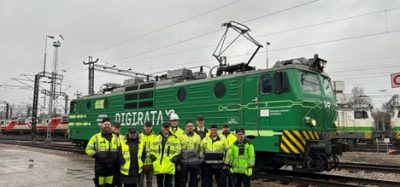ERTMS strategy and planning in Sweden
Posted: 31 May 2006 | | No comments yet
The Swedish government has clearly indicated its commitment to railways as one of the most important means of transportation for the future. As a consequence, Banverket has been provided with resources to carry out an enhancement program needed to fulfil the transport policy objectives.
The Swedish government has clearly indicated its commitment to railways as one of the most important means of transportation for the future. As a consequence, Banverket has been provided with resources to carry out an enhancement program needed to fulfil the transport policy objectives.
The Swedish government has clearly indicated its commitment to railways as one of the most important means of transportation for the future. As a consequence, Banverket has been provided with resources to carry out an enhancement program needed to fulfil the transport policy objectives.
Banverket has the responsibility to develop the railway system with the objective to fulfil primary customer needs such as; increased availability, higher capacity, improved safety and better cost-efficiency.All activities shall be carried out within the scope of lowering environmental impact and stimulating regional area development.
The EU has through directives and technical standards for interoperability requiring the development of a common and harmonised railway train control system, ERTMS, to be implemented on TEN railway networks in Europe. Sweden has accordingly implemented these requirements in a new national railway legislation and also extended the application of the law to cover, not only the TEN lines, but the complete railway network in Sweden.
The basic planning for the necessary development and deployment regarding the implementation of ERTMS in Sweden is defined in a document called the Future Plan. The content of this governmental investment plan, covering the period of 2004-2015, has been presented to the EC as part of the member state responsibility of providing information regarding ERTMS planning.
Main drivers for implementation of ERTMS in Sweden
Today, it is quite obvious that prerequisites and opportunities concerning implementation of ERTMS are very different from one European railway to another. The Swedish railway in this comparison maybe somewhat fortunate since there is an existence of essential drivers that are expected to lead to an overall enhancement of railway transportation and operation.
The most important drivers for implementing ERTMS in Sweden are as follows:
- Interoperability
- Intraoperability
- A majority of legacy signalling systems and ATP that are old and need replacing
- Train speeds over 200km/h supported
- Freight trains can utilise the tracks better, based on individual braking performance
- Increased availability trackside (limited number of optical signals)
- Increased capacity
- Increased safety
- Enhanced cost efficiency due to standardisation and improved asset management
- Regional ERTMS for low density lines (very cost-efficient solution)
Strategy
Currently, the existing Swedish railway network consists of 22% High Speed lines (TEN-lines) and 24% Conventional lines (TENlines) which are all remotely controlled and fully equipped with ATP. Approximately 20% of the network is operated using manual dispatching based on vocal communication.The remaining part of the network basically consists of remotely controlled regional lines equipped with ATP.
With regards to rolling stock, there are more than 1,000 engines and train sets in operation – being equipped with ATP on-board.Additionally, there are approximately 200 special vehicles used for maintenance and production of which only 26 have ATP on board. Generally, traffic conditions are based on operation of high speed trains and freight trains in mixed traffic using the same tracks. There is also extensive circulation of engines and wagons all over the country.
The overall implementation strategy for Sweden is to equip the train-sets and locomotives to such an extent that trains can operate on both ERTMS-equipped tracks as well as on tracks equipped with legacy systems. All ERTMS levels (Level 1-3 & Level STM) will be used trackside which implicates that the onboard installation must include ETCS as well as GSM-R Euroradio and STM.
A fully fledged radio based ERTMS system demands a GSM-R trackside installation that provides the necessary QoS requirements for every application. This was considered in 1997 when Banverket, as one of the first large scale implementers of GSM-R, procured the system. The deployment of GSM-R in Sweden is well underway and will reach the coverage needed for a full ERTMS deployment in just a few years of time.
Focusing on the ERTMS strategy trackside, Level 2 is the preferred option and will be implemented where possible. Level 1 is expected to be needed on large stations and major hubs where complicated traffic situations occur. Level 3 (fixed virtual block system based on UIC FRS ERTMS Regional) will be implemented on low traffic lines as a means of remote control and a replacement of manual dispatching (ERTMS Regional will allow the use of train detection devices making it suitable for low traffic Level 2 applications as well).
Development
Introducing a new train control system such as ERTMS, and in particular Level 2/3, will have an impact on most systems within the Control, Command and Signalling environment. In order to utilise the new and enhanced functionality of ERTMS, major modifications or upgrading of interlockings and CTC can become necessary. This is partly the case in Sweden where implementation of ERTMS Level 2 will most likely cause a complete replacement of relay based interlockings on the lines concerned. It is not yet fully analysed whether there will be a major impact at CTC level as well, or if it will be sufficient to modify the CTC systems according to the new functionality introduced at interlocking/RBC level due to ERTMS requirements. It would be too easy to think that ERTMS on-board equipment is really off-the-shelf and can be installed on a locomotive without additional development and adaptation. National add-ons should of course be avoided in order to reach harmonised European solutions and to facilitate cross-acceptance in the future. However, the European sets of specifications are still not fully in place to fulfil the performance requirements for train operation, based on ERTMS in the Nordic countries. Functionality concerns the supervision of level crossings, STM European mode and an optimised braking algorithm that makes use of service brake intervention without creating long pre-signalling distances. It will surely not be accepted by the train operators to introduce a new train control system with less performance than the existing one.
It was anticipated at an early stage that the implementation strategy for Sweden was strongly dependent on a fully developed and validated STM to be in place of large scale installations on locomotives and train-sets in due time before the big roll-out of trackside ERTMS would take place. In response to this, Banverket, together with JBV (Norway) and RHK (Finland), signed contacts for the development of a Nordic STM in 2004. Series delivery of STMs are planned to start in 2008.
Banverket, JBV and RHK, in cooperation with Nordic train operators, are planning to jointly launch a call for tender late this year regarding a long term frame agreement covering development and delivery of ERTMS on-board equipment for the Nordic market.An additional call for tender regarding ERTMS Level 2 trackside equipment is expected to be launched at the same time.
Implementation principles
Normally, when a new technical system is to be developed, conceptual design work must be prepared in order to specify basic parameters of the system and to set up prerequisites and conditions under which the system shall be applied and operated. Requirements concerning functionality, performance and interfaces must be elaborated and specified to such an extent that implementation can be completed with a minimised risk of misinterpretation of customer needs and still leaves as much freedom as possible for different technical solutions on the supplier side. This is in accordance with the CENELEC standard EN 50126 which has been used by Banverket for many years.
All new technical development of train control systems will follow the above mentioned principle.As an example, the development of an ERTMS Level 2 trackside system will most likely include architectural and interface requirements. Open interfaces and the use of Banverket IP-based intranet is strongly preferred. The use of GSM-R/GPRS for different applications will be considered where appropriate.
The acronym STEG in the figure refers to a new high level train control system based on an electronic time graph replacing the paper based one.
Deployment plans The following map indicates the planned trackside implementation of ERTMS as defined in the Futureplan. Currently, the plan covers ERTMS Level 2 implementation on the line starting at the Öresund Bridge in the south and ending at Umeå in the north (including the Botnia line). It also covers all investments to be completed concerning ERTMS Regional on 12 manually operated lines. The implementation is expected to continue after 2016 on the lines forming a triangle between Malmö, Gothenburg and Stockholm as well as the international lines connecting to Norway.
Project risks and constraints
Projects introducing new technology normally have to deal with substantial project risks.Add to that the huge and necessary management of safety related hazards and you will have prerequisites that fit well into the description any ERTMS implementation project. The Swedish ERTMS implementation project will surely not be an exception. Some of the identified major risks and real show stoppers are highlighted below. Substantial efforts are thoroughly underway to reduce at least some of the risks to create enough guts to place the two calls for tenders earlier mentioned on the European market late this year.
Expected cost
Financing of development and trackside implementation within the period of 2004-2015 are defined in the future plan, but the financing plan for on-board equipment is not yet in place.
The complete implementation cost of ERTMS in Sweden is estimated to be approximately €1.5–2 billion. Banverket and many of our partners within the Nordic railway sector consider investments in ERTMS to be very good investments for the future that will enhance cost-efficiency and competitiveness in railway transportation.







